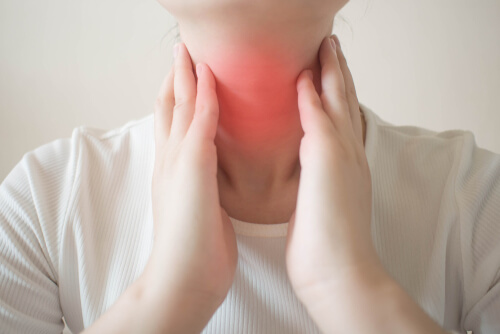Thyroid Disorders - DRHC Dubai Internal Medicine Clinic
The thyroid gland is an endocrine gland located in front of the neck below the Adam's apple. It consists of two lobes connected by Isthmus. It secretes three Hormones T3 (Triiodothyronine), thyroxine T4 and Calcitonin.
What is the Function of Thyroid Gland?
- The thyroid hormone influences the metabolic rate, protein Synthesis, and in children's growth and development.
- The function of the thyroid gland is regulated by a feedback mechanism involving the brain. When the thyroid hormone level is low, Hypothalamus releases TRH (Thyrotropin Releasing Hormone) that causes the pituitary hormone to release TSH. TSH stimulates the thyroid gland to release more T4.
- Disorder of the thyroid gland is from an autoimmune process That stimulates the overproduction (Thyrotoxicosis) or causes glandular destruction and underproduction of thyroid hormone (Hypothyroidism).
- Etiology; Autoimmune diseases and Iatrogenic causes are the most common causes of Hypothyroidism.
Causes of Hypothyroidism:
- Autoimmune Hypothyroidism: Hashimoto’s thyroiditis, Atrophic thyroiditis
- Drugs: Amiodarone, Lithium, Antithyroid drugs, Interferon alfa.
- Infiltrative Disorders, Amyloidosis, Sarcoidosis Scleroderma
Secondary Hypothyroidism:
- Hypopituitarism: Tumors, surgery, infiltrative Disorders
- Isolated TSH Deficiency or inactivity
- Hypothalamic Disease: Tumors, Infiltrative Disorders, Idiopathic
Symptoms of Hypothyroidism:
- Lethargy
- Weakness
- Intolerance to cold
- Dry Hair & Skin
- Constipation
- Weight gain with poor appetite
- Dyspnea
- Hoarse Voice
- Poor Memory
- Muscle Cramping
- Menorrhagia
The most extreme presentation is a dull, expressionless face, sparse hair, periorbital puffiness, large tongue, and pale doughy, cool skin.
Diagnosis:
- Decreased serum-free T4 (FT4) is common in all varieties of Hypothyroidism.
- Increased TSH is a sensitive marker for primary hypothyroidism.
- Thyroid peroxidase (TPO) antibodies are increased in >90%of autoimmune mediated hypothyroidism.
- Increased cholesterol and anemia may present
- ECG may show bradycardia (Decreased Heart Rate), low voltage QRS complexes, and flattened and inverted T waves.
Treatment: Replacement of levothyroxine (T4) daily. The dose should be adjusted on the basis of TSH levels.
Hyperthyroidism: Overactive thyroid gland
- Primary hyperthyroidism: Graves Disease
- Toxic multinodular goiter
- Toxic adenoma
- Iodine excess
- Thyroid destruction: Subacute thyroiditis, Amiodarone, Radiation
- Secondary Hyperthyroidism: TSH secreting Pituitary Adenoma
- Human chorionic gonadotropin (HCG) secreting tumor
- Gestational thyrotoxicosis
Symptoms:
- Nervousness
- Irritability
- Heat intolerance
- Excessive sweating
- Palpitations
- Fatigue & Weakness
- Weight Loss with increased appetite
- Diarrhea
- Oligomenorrhea
- Skin is warm and moist
- Eyelid retraction, lid lag may present
- Tachycardia (Increased Heart Rate)
- Fine tremors
- Proximal muscle weakness
Graves’ Disease: Caused by activating TSH-receptor antibodies, the most common cause of thyrotoxicosis affecting more than 60-80%of cases.
- Prevalence in females is more than 10-fold higher than in males
- In Graves’ Disease thyroid is enlarged diffusely 2 to 3 times its normal size
- Ophthalmopathy proptosis, Periorbital swelling, and ophthalmoplegia
- Pretibial myxedema
Subacute thyroiditis: Tender, enlarged with referred pain to the jaw or ears sometimes accompanied by upper respiratory tract infection and fever\
Solitary or multiple nodules may be present in toxic adenoma or toxic multi-nodular goiter
Thyroid crisis / Thyroid Storm: It is rare, presented as a life-threatening exacerbation of hyperthyroidism, and accompanied by fever, delirium, seizures, arrhythmias, diarrhea, vomiting, and coma.
Diagnosis: TSH and unbound T4 high
Thyroid Radioiodine uptake: High uptake in Grave’s disease and Nodular Disease. Low Uptake in thyroid destruction, Iodine Excess, and Extra thyroidal Source of Thyroid hormone.
- ESR is elevated in subacute thyroiditis.
- Elevation of bilirubin, liver enzymes, ferritin
Treatment for Grave’s disease:
- Treated with anti-thyroid drugs such as methimazole, propylthiouracil, or radioiodine.
- Propranolol is useful at the start of treatment to control adrenergic symptoms.
- Radioiodine can be used as an initial treatment or in patients who do not undergo remission after 1-2 years of antithyroid drugs.
- Progressive exophthalmos with chemosis ophthalmoplegia or vision loss is treated with a large dose of prednisone.
- Radioiodine is a treatment of choice for toxic nodules.
- Subacute thyroiditis should be treated with NSAIDs, and beta blockers to control symptoms.
.png?width=281&height=59&name=bookanappointment%20(1).png)
At DRHC Dubai, we are dedicated to providing the highest level of care for patients with Chronic Bronchitis. To learn more about our services or to schedule a consultation with of our Internal Medicine Clinic, please contact us today at +97142798200.




.png?width=281&height=59&name=bookanappointment%20(1).png)

-1.webp?width=800&height=800&name=19-2%20(1)-1.webp)
